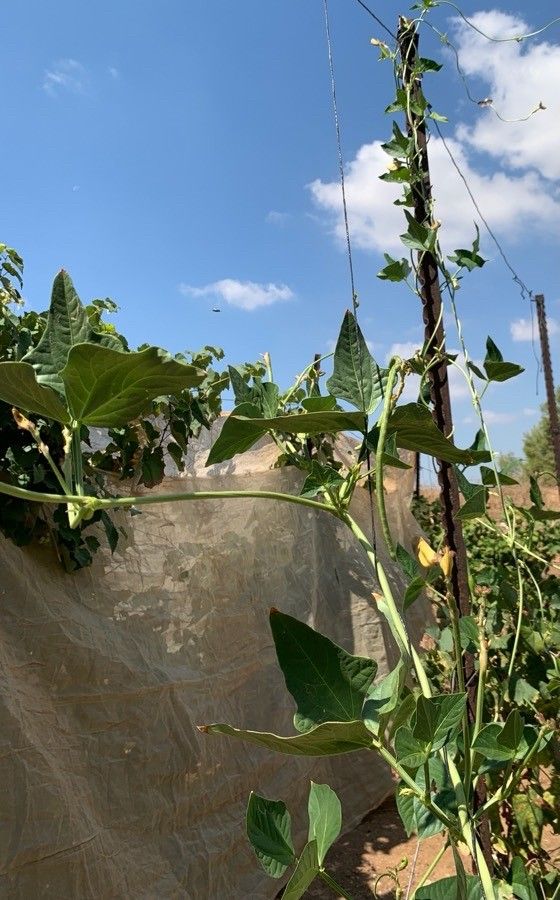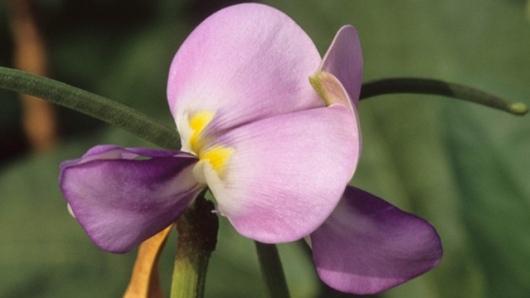Cowpea
vigna unguiculata
Also known as: ["Black-eyed pea","Crowder pea","Lima bean"]
Overview
A leguminous plant cultivated for its edible seeds, widely grown in tropical and subtropical regions.
Benefits & Perks
["edible fruits","drought tolerant","wildlife attractant (bees, butterflies, birds)"]
Botanical Classification
| Phylum: | Magnoliophyta |
| Class: | Magnoliopsida |
| Order: | Fabales |
| Family: | Fabaceae |
| Genus: | Vigna |
| Botanical Name: | Vigna unguiculata |
Plant Characteristics
Basic Information
- Category: Fruits
- Suitable Location: outdoor garden bed in full sun, or large container in a sunny spot
- Suitable For:
- Is Weed: No
- Allergenicity: low
Environmental Needs
- Climate: {"temperatureRange":"18–35°C"}
- Hardiness: {"zones":"9–11"}
- Misting: rarely required, only if ambient humidity is very low
- Drainage: Well-draining to fast-draining.
- Soil Type: Rich, loamy soil with good organic matter; well-draining.
Maintenance Level
- Maintenance Level: moderate
- Toughness Level: high
- Pruning Frequency: As needed; light pruning during growing season.
- Pruning Intensity: Light to moderate; avoid heavy pruning unless necessary.
Care Details
Ideal Sunlight Coverage:
Full sun (6–8 hours/day); partial shade in extreme heat; adjust based on intensity.
Sunlight Tolerance Tips:
Acclimate gradually to intense sun; protect from scorching midday rays; provide shade during heatwaves.
Care Requirements
Care Difficulty
easyeasy
Sunlight
full sun
Rotate plants for even light; use shade cloth in summer; avoid direct sun on leaves.
Watering
every 3–5 days during active growth, reduce in winter
Water at the base to avoid foliage wetting; ensure soil dries between waterings; adjust based on weather and growth stage.
Soil
well-draining, loamy soil with moderate organic matter
pH: Slightly acidic to neutral (6.0–7.0).
Avoid waterlogged soil; enrich with organic matter; test pH annually.
Temperature
Warm conditions (65–85°F/18–29°C); intolerant of frost; prefers stable temperatures.
Avoid sudden temperature shifts; protect from frost; maintain warmth during flowering.
Fertilizing
every 2 weeks during growing season with balanced liquid fertilizer, every 3 months otherwise
Use a balanced NPK ratio; apply after watering; flush soil occasionally to prevent salt buildup.
Propagation
Methods
Seeds (direct sowing or indoor starting); stem cuttings less common.
Step-by-Step Propagation Guide
- Sow seeds 1 inch deep.
- Thin seedlings.
- Provide support for climbing varieties.
Best Time: Spring or early summer for optimal germination and growth.
Environment
Warm (70–80°F/21–27°C), bright indirect light, moderate humidity.
Medium
Well-draining seed starting mix or sandy loam.
Hormone
Not typically needed for seeds; rooting hormone optional for cuttings.
Timeline
Germination in 7–14 days; plants mature in 60–90 days.
Tools Needed
Seeds, soil, pots, water, support stakes (if needed).
Quick Tips
Sow seeds in groups of 2–3; keep soil consistently moist; thin to strongest seedling.
Pruning & Repotting
Pruning Guide
Method
Pinch back tips for bushier growth; remove yellow or damaged leaves.
Pruning Plan
Minimal pruning; focus on removing dead or diseased growth; train vines for better air circulation.
Tools
Pruning shears, gloves, clean blades.
Checklist
Sanitize tools; prune dead/diseased parts; improve air circulation; train vines.
Repotting Guide
Best Season
Early spring before active growth begins.
Pot Size
One size larger pot; ensure adequate root space.
Method
Use fresh well-draining soil; gently tease out roots; ensure proper drainage.
Suggestions
Not typically needed for outdoor plants; container plants may need repotting every 2–3 years.
Checklist
Check root bound status; prepare new pot; use fresh soil; water after repotting.
Advanced Care Tips
Watering Mastery
Watering Checklist
Check soil moisture; water deeply; ensure drainage; adjust seasonally.
How to Apply Water Properly
Water thoroughly until it drains from the bottom, ensuring root zone saturation; avoid overhead watering to prevent fungal issues; water early in the day to minimize evaporation.
Watering Schedule Tips
Water deeply once the top inch of soil is dry; reduce frequency during winter dormancy; increase during flowering and fruiting stages.
Soil Improvement
Add compost or aged manure; incorporate perlite or sand for drainage; mulch to retain moisture.
Temperature Stress Management
Signs of Temperature Issues
Wilting, leaf drop, stunted growth, or flower abortion.
Cold Stress
Growth halts, leaves turn yellow or brown, potential frost damage.
Solution: Provide frost protection; move indoors in cold climates; use row covers or cloches.
Hot Stress
Wilting, leaf scorch, reduced flowering, or pod abortion.
Solution: Provide shade, increase watering, use mulch to retain moisture, or mist foliage.
Fertilizing Guide
Fertilizing Checklist
Check fertilizer type; dilute properly; apply during active growth; avoid contact with roots.
Fertilizing Method
Balanced liquid fertilizer every 4–6 weeks during growing season; reduce in winter; avoid over-fertilizing.
Common Problems & Solutions
Toxicity Warning
Cats
Non-toxicCowpeas are not toxic to cats, but raw seeds can lead to mild gastrointestinal discomfort due to antinutritional compounds.
⚠️ Symptoms:
🌿 Toxic Parts:
⚡ Toxic If:
if eaten raw
Dogs
Non-toxicCowpeas are not inherently toxic to dogs, but raw seeds may cause mild gastrointestinal upset due to the presence of lectins.
⚠️ Symptoms:
🌿 Toxic Parts:
⚡ Toxic If:
if eaten raw
Humans
Non-toxicVigna unguiculata, commonly known as cowpea, is generally non-toxic when properly cooked. However, raw seeds contain lectins and other antinutritional factors that can cause gastrointestinal distress.
⚠️ Symptoms:
🌿 Toxic Parts:
⚡ Toxic If:
if eaten raw
Frequently Asked Questions
Q: Is cowpea suitable for beginners?
A: Yes, cowpea is easy to grow and suitable for beginners.
Q: Can cowpea be grown in drought conditions?
A: Yes, cowpea is drought tolerant and can thrive in dry conditions.
Q: Does cowpea attract wildlife?
A: Yes, cowpea attracts bees, butterflies, and birds, making it beneficial for wildlife support.
Quick Reference
| Family: | Fabaceae |
| Care: | easy |
| Light: | full sun |
| Water: | every 3–5 days during active |
Get Expert Care Tips
Download the Plantious app for personalized care reminders and plant identification!
Google Play App Store








